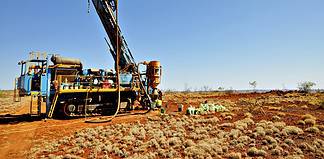Going For Gold In Papua New Guinea

With bilateral trade of over $6b in 2020, Australia is Papua New Guinea’s (PNG) biggest trade partner. Australia is also a major investor in PNG, with investment valued at around $248b in 2021.
The Australian Bureau of Statistics (ABS) has indicated more than 4000 Australian companies export to PNG and according to the Federal Government’s Foreign Affairs and Trade Department, Australia is PNG’s largest development partner and main economic and security partner.
Its major export markets include Australia, China, Japan, Taiwan and South Korea with leading products including petroleum gas, gold, copper ore, crude petroleum and rough wood.
Gold mineralisation was discovered at the Lihir gold mine in 1982. A major exploration campaign was then undertaken between 1982 and 1992 by a joint venture between Kennecott Explorations Australia and Niugini Mining.
The Lihir gold operation is located on Aniolam Island, the largest island in the Lihir Island group. Aniolam Island lies around 900km northeast of Port Moresby in the New Ireland Province of Papua New Guinea.
Under the original project approvals, the Lihir project was transferred to a new company, Lihir Gold Limited (LGL). Rio Tinto (ASX:RIO) then established Lihir Management Company to develop and operate the mine on behalf of LGL.
The Lihir gold operation became wholly owned and operated by LGL in 2005 after Rio divested its interests in the operation.
Five years later in August 2010, Newcrest Mining (ASX:NCM) acquired the Lihir operations following the merge between Newcrest and LGL.
Gold Production
The gold deposit at Lihir lies within the Luise Caldera, a geothermally active extinct volcanic crater. It is one of the largest known gold deposits in the world.
The majority of the ore produced at Lihir is refractory and treated using pressure oxidation before the gold is recovered via conventional leach process.
Between 1997 and 2008, gold production increased from 232,697oz to over 700,000oz. In FY23, Lihir produced 670,000oz of gold at an all-in sustaining cost of $1466/oz.
The process plant has undergone a major expansion which included the installation of a new crushing facility and upgrades to the ore processing plant. This plant expansion will increase flexibility of the operation, improve the reliability of the equipment and lower fixed costs per tonne.
Lihir Phase 14A
In January 2023, the board of Newcrest approved the Lihir phase 14A feasibility study, endorsing the project into full implementation.
Phase 14A represents an extension of the Phase 14 cutback that involves safely steepening the walls of the pit by using civil engineering techniques to access existing indicated mineral resources.
It will provide an additional high-grade ore source that will displace low grade stockpile feed which is required as the mine moves through the transitional zone between FY23 and FY27.
Newcrest interim chief executive Sherry Duhe commented on the study at the time.
“The development of phase 14A is another innovative step forward in realising the full potential of Lihir,” she said.
“The findings of the study are expected to deliver gold production from an additional high grade ore source which would have otherwise been inaccessible through standard mining techniques.”
Ore mined from Phase 14A will displace lower grade ore feed to the processing plant with around 13mt of high and medium grade ore expected to be fed through to FY26 to produce an incremental 400,000oz of gold.
The lower grade material will be stockpiled and fed progressively over the remaining mine life.
Phase 14A higher grade ore is expected to be delivered from FY24 and studies are underway to potentially extend the elevated production profile beyond FY31.
At the completion of Phase 14A mining, the high wall is expected to be buttressed with backfill to provide long term stability.
Sustainability and Community
Lihir creates economic value for PNG and local communities, including direct revenues from operations, investment in public infrastructure and services, and supporting local suppliers.
Around 4500 people are employed at Lihir and roughly 90% of the employees are Papua New Guineans.
Where possible, Newcrest supports PNG-based suppliers and businesses, consistent with its commitments to landowners and the PNG Government.
Newcrest also contributes to the local economy by providing public infrastructure and services, including access to health services and providing electrical power and water to local villages.
Since 2003, geothermal energy has been used at Lihir to provide some of the operation’s power needs and reduce greenhouse gas emissions.
Further, it maintains an ISO 14001 certified Environmental Management System (EMS), which assists in the planning and implementation of environmental management measures.
Newmont Acquisition
In early February 2023, Newcrest confirmed it had received an offer from Newcrest to acquire the company for $29b (US$19b).
Newmont president and chief executive Tom Palmer commented on the acquisition and Lihir in a recent presentation.
“Moving up to Papua New Guinea, Lihir is one of the world’s great gold mines, a Tier 1 operation by any measure,” he said.
“And in addition to Lihir, there is significant gold and copper growth in PNG through the world class Wafi-Golpu project.
“We are committed to building and maintaining strong, proactive, mutually beneficial and long-lasting relationships with the PNG government and local communities while supporting safe and profitable operations.
“As part of this commitment, Newmont plans to establish PNG as a standalone the fifth region in our portfolio with an in-country senior leadership presence.”
Newmont has received clearance from the Korea Fair Trade Commission, Papua New Guinea’s Independent Consumer and Competition Commission and the Australian Competition and Consumer Commission, while the Canadian Competition Bureau issued a “no action” letter.
Pending approvals include the Australia Foreign Investment Review Board, the Japan Fair Trade Commission and the Philippine Competition Commission.
The transaction is expected to be completed in the fourth quarter of this year.








































